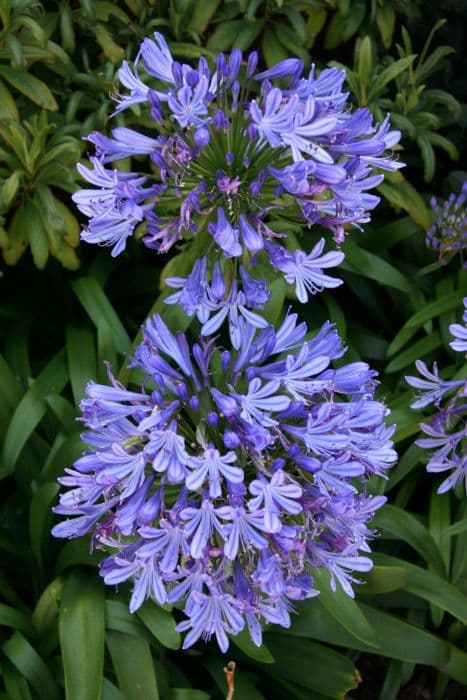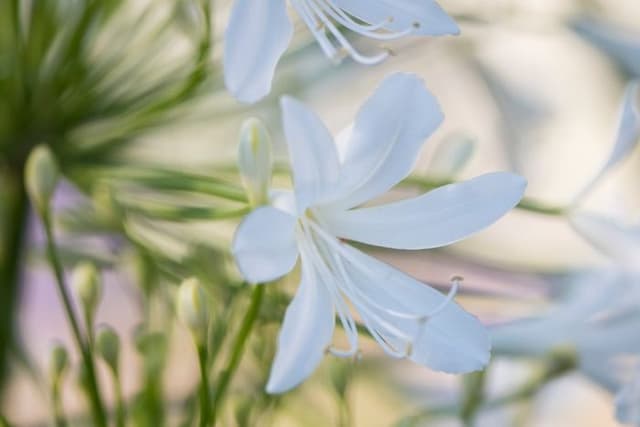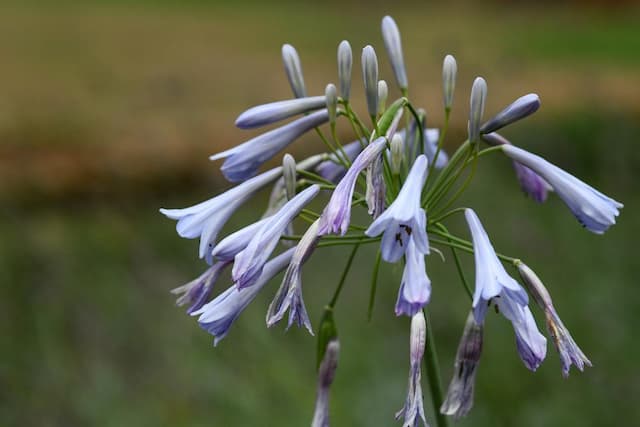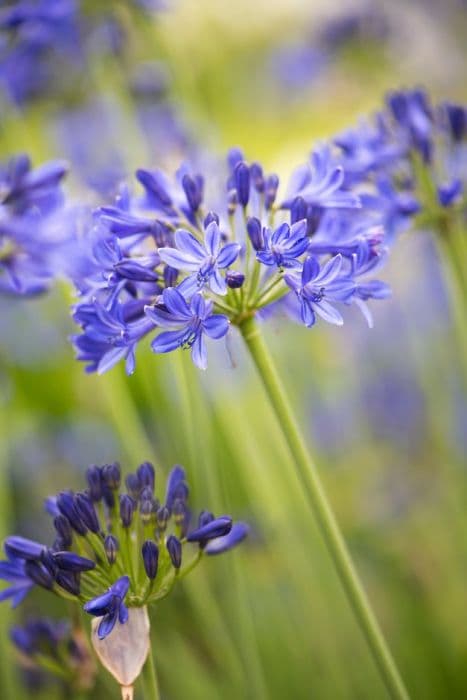African Lily Agapanthus 'Hoyland Blue'

ABOUT
Agapanthus 'Hoyland Blue', commonly known as Lily of the Nile, is a striking ornamental plant with lush, strap-shaped leaves that create a dense, fountain-like clump. The foliage is bright green, contributing to its vibrant appearance throughout the growing season. The real showstoppers, however, are the globular clusters of trumpet-shaped flowers, which come in a ravishing shade of blue. These blossoms are arranged in rounded clusters, known as umbels, atop sturdy, upright stems that rise elegantly above the foliage. The deep blue flowers are particularly striking, as they tend to catch the eye from a distance and can add a touch of sophistication to any garden setting. The contrast between the blue blooms and the green leaves creates a picturesque display that is both bold and delicate. The perennial nature of 'Hoyland Blue' ensures that it brings beauty to the garden year after year, with the blooming season typically occurring in summer, offering a refreshing splash of color during the warmer months.
About this plant
 Names
NamesFamily
Amaryllidaceae.
Synonyms
African Lily, Lily of the Nile, Love Flower.
Common names
Agapanthus 'Hoyland Blue'
 Toxicity
ToxicityTo humans
The Agapanthus, commonly known as Lily of the Nile or African lily, may be harmful if ingested. All parts of the plant contain compounds that can cause symptoms if eaten, such as nausea, vomiting, and diarrhea. Ingesting significant quantities may lead to more severe reactions, including abdominal pain, weakness, and an increase in saliva production. It is advisable to seek medical attention if any part of the plant is consumed.
To pets
The Agapanthus, or African lily, is toxic to pets, including cats and dogs. It contains substances known to cause gastrointestinal upset, with symptoms such as vomiting, diarrhea, and drooling. If a pet consumes a considerable amount of any part of the African lily, more serious health issues can arise, such as tremors or cardiac problems. Immediate veterinary care should be sought if ingestion is suspected.
 Characteristics
CharacteristicsLife cycle
Perennials
Foliage type
Evergreen
Color of leaves
Green
Flower color
Blue
Height
2 feet [60 cm]
Spread
2 feet [60 cm]
Plant type
Bulb
Hardiness zones
8
Native area
South Africa
Benefits
 General Benefits
General Benefits- Ornamental Appeal: The Agapanthus 'Hoyland Blue', commonly known as the African Lily, bears beautiful blue flowers that enhance the aesthetics of gardens and landscapes.
- Low Maintenance: African Lilies are known for being low maintenance, requiring minimal care once established, making them suitable for gardeners of all skill levels.
- Drought Tolerance: Once established, they are relatively drought-tolerant, making them ideal for water-efficient gardens and regions with water restrictions.
- Long Blooming Season: They offer a long blooming season, often from early summer to fall, providing extended periods of visual interest.
- Attracts Pollinators: The blossoms of African Lily attract beneficial pollinators such as bees and butterflies, promoting biodiversity.
- Versatile Landscaping: Agapanthus can be used in a variety of landscaping settings including borders, pots, and as focal points in garden beds.
- Tolerates Different Soil Types: This plant can thrive in a range of soil types, although it prefers well-drained soil, making it adaptable to different garden conditions.
- Deer Resistance: African Lilies are often resistant to deer, reducing the risk of damage and the need for protective measures in gardens where deer are common.
- Clumping Growth: The plant grows in clumps, which can be easily divided to propagate new plants and expand garden displays or share with others.
 Medical Properties
Medical PropertiesThis plant is not used for medical purposes.
 Air-purifying Qualities
Air-purifying QualitiesThis plant is not specifically known for air purifying qualities.
 Other Uses
Other Uses- As a natural dye: The blossoms of the Agapanthus can be used to produce blue and purple dyes for fabrics and textiles.
- In arts and crafts: The robust stalks and dried flower heads can be incorporated into floral arrangements and other decorative crafts.
- Photography subject: Agapanthus 'Hoyland Blue' can be a captivating subject for photographers due to its vibrant blue hues and striking appearance.
- Garden borders: Planting Agapanthus along pathways or around garden beds can create a striking border that defines the area with its lush foliage and blossoms.
- Erosion control: Agapanthus plants can be used on slopes or areas susceptible to erosion because their roots help hold the soil in place.
- Ponds and water feature accents: Agapanthus can be planted around ponds or water features where their reflection enhances the beauty of the setting.
- Culinary garnish: The flowers, although not widely known for culinary uses, can be used as an ornamental garnish for special dishes.
- As cover for ground: Agapanthus can serve as a ground cover in gardens, filling spaces with its dense foliage and reducing weed growth.
- In perfumery: Occasionally, the subtle scent of Agapanthus flowers may be used in crafting unique perfumes or scented products.
- Holiday decorations: Agapanthus flowers can be dried and utilized in creating festive wreaths and ornaments during the holiday season.
Interesting Facts
 Feng Shui
Feng ShuiThe Lily of the Nile is not used in Feng Shui practice.
 Zodiac Sign Compitability
Zodiac Sign CompitabilityThe Lily of the Nile is not used in astrology practice.
 Plant Symbolism
Plant Symbolism- Love Letters: The name "Agapanthus" comes from the Greek words 'agape', meaning love, and 'anthos', meaning flower. Thus, this plant is often associated with love and can symbolize an overflow of feelings or the conveyance of messages from the heart.
- Beauty: Agapanthus, commonly known as African Lily, is admired for its stunning blue flowers, which can symbolize beauty and elegance in floral language due to its eye-catching appearance.
- Enduring Love: African Lilies are known for their toughness and perennial nature, making them a symbol of lasting and resilient love that endures over time.
- Fertility: The lush and abundant blooms of the Agapanthus 'Hoyland Blue' can also represent fertility or the inception of new ideas and ventures, drawing parallels to growth and abundance.
- Protection: In some cultures, the Agapanthus is believed to ward off evil spirits and is planted around homes for protection, symbolizing safety and creating a shield against negativity.
 Water
WaterLily of the Nile should be watered deeply once a week, ensuring that the soil is moistened to a depth of 5 to 6 inches, which is roughly equivalent to about 1 to 1.5 gallons of water per plant in average soil conditions. In hot or windy weather, it may require more frequent watering to maintain consistent soil moisture. During the rainy season or cooler months, reduce the frequency to account for increased soil moisture. It's important not to overwater, as this can lead to root rot. Always allow the top inch of soil to dry out before watering again.
 Light
LightLily of the Nile thrives in full sun to partial shade. The plant performs best when it receives at least 6 hours of sunlight a day. However, in very hot climates, some afternoon shade can help protect the plant from excessive heat stress. A spot that receives morning sun and dappled afternoon shade is ideal in such conditions.
 Temperature
TemperatureLily of the Nile does well in a temperature range between 60 to 80 degrees Fahrenheit but can tolerate temperatures as low as 50 degrees Fahrenheit without serious damage. It is not frost-hardy, so if temperatures are expected to dip below 50 degrees, consider providing protection or moving potted specimens indoors. Ideal growth occurs when temperatures are consistently within the aforementioned range.
 Pruning
PruningPrune Lily of the Nile to remove spent flower stalks and to tidy up any dead or damaged foliage, which promotes healthy growth and improves the plant's appearance. This is usually done after flowering ends in late summer or early fall. Periodic removal of old leaves throughout the growing season can also be beneficial. It is not necessary to prune aggressively, as the plant maintains a neat form naturally.
 Cleaning
CleaningAs needed
 Soil
SoilAfrican Lily thrives in loamy, well-drained soil with a pH of 6.0 to 8.0. A mix containing peat, perlite, and compost is ideal, promoting good drainage and fertility.
 Repotting
RepottingAfrican Lily should be repotted every two to three years, or when it outgrows its current pot, to allow ample room for its roots to expand.
 Humidity & Misting
Humidity & MistingAfrican Lily prefers moderate to high humidity levels but is quite adaptable and can tolerate lower humidity without adverse effects.
 Suitable locations
Suitable locationsIndoor
Place African Lily in bright, indirect light with well-draining soil mix.
Outdoor
Plant African Lily in full sun to partial shade in fertile, well-drained soil.
Hardiness zone
8-11 USDA
 Life cycle
Life cycleThe Agapanthus, commonly known as Lily of the Nile, begins its life cycle when a seed germinates in well-drained soil, typically during the spring season. After germination, the seedling grows into a juvenile plant, developing strap-like leaves and establishing a root system. As it matures, which may take several years, it forms clumps with more foliage and begins to send up tall flower stalks during the summer, which bear rounded clusters of trumpet-shaped, blue flowers. Following flowering, these blooms may give way to seedpods if pollinated, continuing the cycle as the pods eventually dry and release seeds. During autumn, the plant starts to enter a period of dormancy, with foliage dying back in colder climates, though it may remain evergreen in milder zones. Throughout its life, the Agapanthus can also propagate vegetatively by division of its clumping rootstock, typically done in early spring or after the plant has finished flowering.
 Propogation
PropogationPropogation time
Spring to early summer
Agapanthus 'Hoyland Blue', commonly known as African Lily, is most commonly propagated by division. The best time for this method is in the spring or early summer after the plant has finished blooming. To propagate by division, carefully lift the clump from the ground using a spade or garden fork, and gently tease apart the root ball into smaller sections, each with a portion of the rhizome and several shoots. These divisions can be promptly replanted in a sunny location with well-draining soil, spaced about 18 inches (approximately 45 centimeters) apart to allow for growth. Water the newly planted divisions thoroughly to help establish them. It's essential to maintain consistent moisture without overwatering, which can cause root rot.









